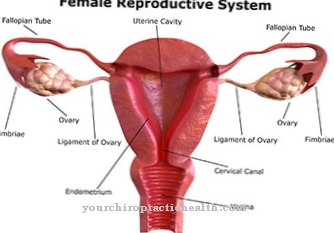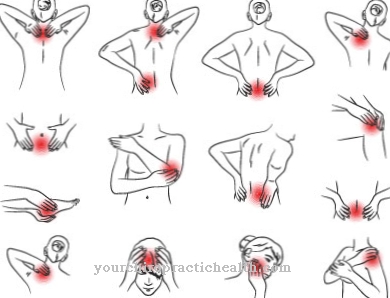The Puerperal fever (Synonyms: Postpartum fever and Puerperal fever) has been an illness of women who have recently given birth and which has been feared since the first hospitals were founded and which previously led to the death of the women concerned in the majority of cases.
What is puerperal fever?

© Jacob Lund - stock.adobe.com
This is one of the diseases that must be classified in the categories of infectious diseases Puerperal fever. Another appropriate name for this disease is puerperal fever.
It is typical of puerperal fever that mothers develop symptoms that have led to death in the past after the birth of a viable child or after a stillbirth. Nowadays, puerperal fever is very rare and can be treated well.
Childbed fever is blood poisoning, which was discovered by the Viennese doctor Ignaz Semmelweiß. He also developed the appropriate preventive methods to avoid childbed fever. Childbed fever has therefore lost its horror today.
causes
The causal triggers leading to the Puerperal fever cause microbial pathogens that include bacteria. They are carried over by inadequate hygienic conditions or by insufficient hand, instrument and device disinfection and sterilization.
Since the birth canal of women is a large open wound after childbirth, the germs that cause the disease can be introduced very quickly.
Another cause that can trigger a puerperal fever is an incomplete afterbirth. For various reasons, the placenta may not fully loosen after giving birth and residues may remain in the woman's body. Due to the dying tissue, these act like "corpse poisons" and contribute to sepsis or poisoning.
So-called "corpse poison" arises when organs that are no longer living are decomposed by microorganisms and these enter the bloodstream. In addition, cell-damaging decomposition substances are formed which are toxic to the body.
Symptoms, ailments & signs
Childbed fever initially manifests itself through typical fever symptoms. Affected women usually notice an increasing feeling of illness, with complaints such as tiredness, palpitations, nausea and abdominal pain. As the disease progresses, patients vomit repeatedly, with symptoms such as stomach pain and heartburn. In addition, there is an inner restlessness and nervousness, which in severe cases can lead to a panic attack.
The initially slightly increased temperature turns into a severe fever. At the beginning of the disease there are usually only minor health problems. In the later stages, serious complications such as a drop in blood pressure, circulatory shock, and blood poisoning can occur. Another symptom is intermenstrual bleeding and unpleasant smelling bleeding.
Delayed periods or a lack of menstruation are also possible indicators of infection. However, the disease can also progress without such signs. In some patients, further symptoms can occur, depending on the existing illnesses and the severity of the fever.
After a few days at the latest, however, the disease always causes severe discomfort and serious complaints that quickly increase in intensity. Ultimately, the fever leads to a breakdown of the circulatory system. If it is not treated or treated insufficiently, it is almost always fatal.
Diagnosis & course
With current modern medical procedures and methods, there is no longer a problem Puerperal fever diagnose in time and treat without lasting health consequences.
The specialists use antibiotic medication to treat mothers affected by puerperal fever in order to reduce the inflammatory processes in the organism and to inhibit the pathogen's ability to divide. In addition, childbed fever can be treated successfully not only causally, but also symptomatically. In this context, medication against nausea and vomiting, as well as against fever, helps women recover and recover quickly.
It is important that women observe themselves closely during childbed and have themselves examined by the gynecologist. He often prescribes drugs that improve the regression of the uterus and its healing.
Complications
In the worst case, childbed fever can lead to the patient's death. Those affected suffer from a very high fever and usually also from severe pain in the stomach and abdomen. Vomiting and nausea continue to occur. If left untreated, puerperal fever can also trigger circulatory shock, so that those affected may faint and injure themselves if they fall.
As a rule, there is also an inner restlessness and the patients suffer from breathing difficulties and an increased heart rate. If puerperal fever continues to be untreated, acute blood poisoning can occur, which in most cases leads to death. The patient's resilience is significantly reduced by the disease and the individual organs are also damaged.
Without treatment, there is a significant reduction in life expectancy. The treatment of puerperal fever usually takes place through surgery or with the help of medication. The complaints can thus be limited relatively well. With early treatment, there is no reduction in life expectancy.
When should you go to the doctor?
Women who feel excessively exhausted or ill after giving birth should definitely notify their doctor. Puerperal fever is a serious illness that needs to be clarified and treated immediately. If symptoms such as nausea and vomiting, fever or palpitations become noticeable, a doctor must be consulted. Circulatory problems or unusually severe abdominal pain should also be clarified by a doctor in any case in order to avoid life-threatening complications. Medical advice is required at the latest when signs of blood poisoning or impending circulatory shock are noticed.
Women who have had a difficult labor are particularly prone to developing puerperal fever. A doctor should monitor recovery and initiate an investigation if symptoms are mentioned. If you suddenly experience severe pain or gastrointestinal complaints, the doctor must be informed immediately. The same applies to an unusual feeling of illness that rapidly increases in intensity. The right contact person is the clinic doctor or a gynecologist. If in doubt, go to the nearest hospital.
Treatment & Therapy
In medicine, when treating the Puerperal fever spoke of different approaches that result depending on the extent of the disease. The individual procedures are divided into local and general measures.
Local applications are appropriate for puerperal fever if it is found that puerpural ulcers have formed in the uterus. In the case of childbed fever, these are opened surgically or eliminated through the targeted use of caustic solutions.
In order to stabilize the general condition of the mothers, drugs that stimulate and strengthen the circulation and, if necessary, infusions are given. These can be of a purely synthetic or vegetable nature. Breastfeeding children is not possible during puerperal fever.
Despite all treatment options, it must still be assumed today that mothers with puerperal fever can die if they are not treated.
Outlook & forecast
Childbed fever is a potentially life-threatening inflammation of the uterus after birth. The delivery resulted in open wounds that can quickly become infected with invading bacteria. Since the uterus is so attacked, the immune system cannot work as fast as the bacteria can multiply, which is why infection can occur very quickly under unsanitary conditions. The result is blood poisoning with multiple organ failure and subsequent death.
This course was inevitable in centuries past, when antibiotics did not exist. Today, two factors ensure that puerperal fever is no longer the leading cause of death in women immediately after childbirth. On the one hand, the hygienic conditions in hospitals and clinics mean that the wounded uterus is no longer infected. On the other hand, even in the event of an infection with bacteria, there is the option of admitting the woman to hospital and treating her with high-dose antibiotics. This would still make puerperal fever extremely uncomfortable, but a fatal outcome can almost be ruled out in an otherwise healthy woman.
The prospects for a complete cure are therefore good nowadays. It has a positive effect on the prognosis if puerperal fever is recognized and treated as such at an early stage.
prevention
To prevent against Puerperal fever it is imperative to keep contaminants away from the birth wound. Appropriate hygiene as part of surface disinfection is also mandatory against puerperal fever.
In addition, the doctors only use sterile instruments and wear disposable gloves. These measures apply not only to the clinics, but also to home births and must be observed by the helping midwives. If maternal women who have already had puerperal fever are cared for by a midwife, she should initially only provide obstetrics to a limited extent in order to avoid the spread of germs.
The observance of the valid hygiene, disinfection and sterilization requirements is essential in obstetrics as a prevention against childbed fever.
Aftercare
Follow-up care is primarily associated with tumors. Doctors hope to be able to treat a recurring and life-threatening disease in its early stages through a tight grid of examinations. Child bed fever can also lead to the death of the young mother. However, there are no other dangers after recovery.
A recurrence of child bed fever would arise from another, but not from the first, birth. Since the mother no longer has any complaints, no follow-up care is necessary immediately after the original diagnosis. The risk of death can be prevented. The nursing staff is responsible for this. On the one hand, adequate hygienic standards ensure that illness does not arise in the first place.
On the other hand, antibiotics realize a cure. In the western industrialized countries, those employed in obstetrics are aware of the risk of puerperal fever. They make sure that complications do not arise in the first place. In this way, they take on the actual aftercare.
Other areas of follow-up care can generally be everyday support and long-term therapeutic treatment. However, both aspects do not come into play in child bed fever. Antibiotics allow a full recovery. The young mother no longer feels any suffering and can continue her life carefree.
You can do that yourself
Puerperal fever has long been one of the leading causes of death in women of childbearing age. The causes are now known and preventive measures and therapeutic methods have been developed to effectively combat this disease. Nonetheless, the disease can still be fatal. Women who observe symptoms of puerperal fever after giving birth must seek medical treatment. Self-therapy of the symptoms is life-threatening.
Puerperal fever manifests itself as a high temperature, nausea and vomiting, and abdominal pain. In severe cases there is even a risk of blood poisoning or circulatory shock. A patient should not let it get that far in the first place and should take all recommended follow-up examinations after the birth. In this way, incipient infections can be recognized and treated at an early stage.
In addition, prevention is very important. When choosing a maternity hospital, women who feel compelled to give birth outside of a western industrial country should make sure that modern hygiene standards are adhered to and that they explicitly ask the staff about them. In the case of a home birth, the midwife's hygiene standards must be checked. Patients should calmly ask which disinfectant is used for their hands and have this shown during a preliminary examination.
If acute puerperal fever has occurred, the patients must absolutely take care of themselves. Under no circumstances should you attempt to breastfeed the newborn during this time.



























